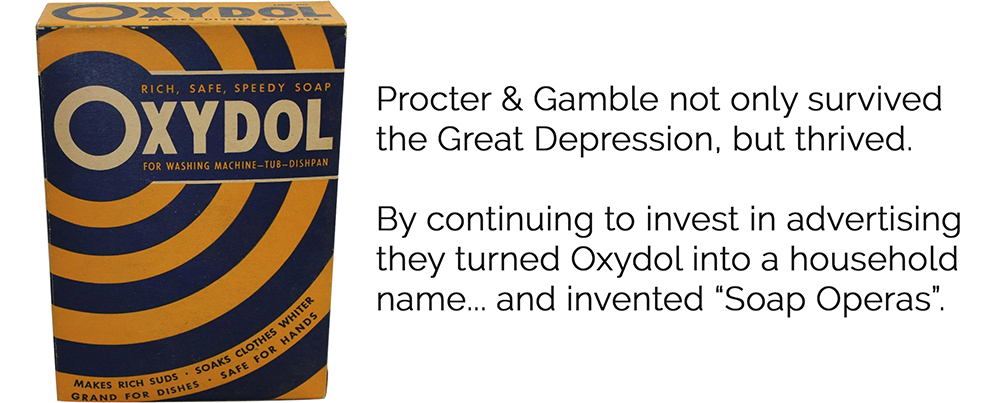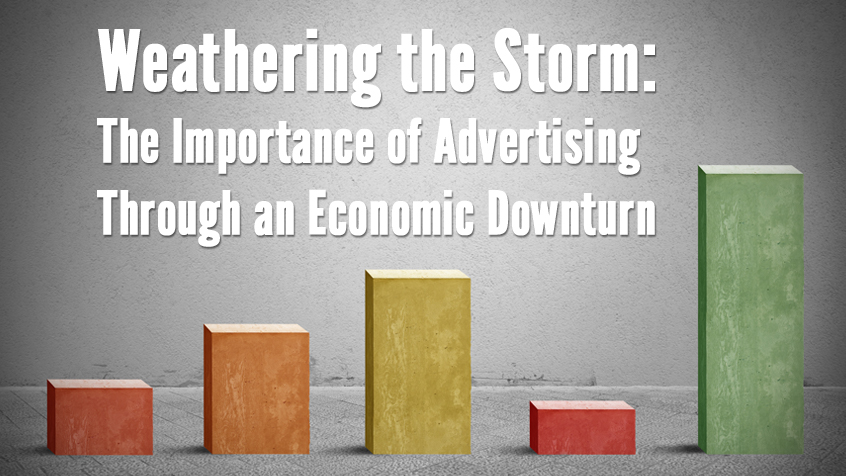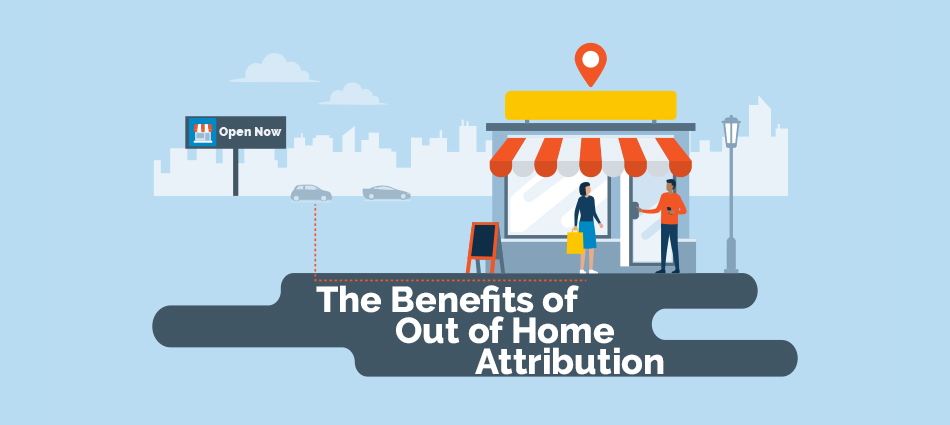Almost everyone has been in a crisis situation at some point in their life, and how we respond is largely governed by who we are – our own personal idiosyncrasies, fears, skills, experiences and abilities. Much of our natural tendencies come from our animal brain – the fight or flight instinct that often overrules our logical brains. But one piece of advice that experts in any field offer is always the same: stay calm. To weather any crisis, it’s most important not to panic.
This is true for marketers, too. The worst thing we can do when faced with a crisis—economic or otherwise—is to panic. Knee-jerk reactions, careening wildly between different (often, contradictory) strategies, flailing at short-term, magic-bullet messiah tactics do nothing but kick up a lot of dust. They usually do more harm than good, sometimes doing damage that businesses can take years to recover from, or even decades.
There have been indicators for some time now that a recession could be on the horizon. And now, with the current health crisis grinding many businesses to a halt, that possibility seems ever more likely. In a recent report, Neil Begley, a senior vice president of Moody’s Investors Service, wrote, “Potential broader coronavirus contagion in the U.S. will have a short-term negative effect on U.S. advertising, stemming from a swift and deep economic pullback. However, the duration of the sector’s contraction may be short-lived.”
How swift? How deep? How short-lived? Well…that we have yet to see. As Henry Ford once said, “Stopping advertising to save money is like stopping your watch to save time.”
“Stopping advertising to save money is like stopping your watch to save time.”
Henry Ford
The evidence goes back almost a hundred years.
Our gut instinct might tell us, “When times are tough, cut costs,” which runs contrary to what we should do. The evidence, however, is extensive, corroborated, and goes back almost a hundred years. Brands who continue to advertise during an economic downturn will do better than their competitors in the long run.
As far back as 1927, advertising executive Roland Vaile published a report in the Harvard Business Review detailing his study of companies during the 1923 recession. Vaile found that companies who continued to advertise came out 20% ahead of where they were pre-recession, while those who reduced advertising ended up 7% below their pre-recession levels.

Then there’s the McGraw-Hill study of brands during the U.S. recessions of the early 1980’s, which tells us that of the 600 businesses they analyzed, those who continued to advertise during the 1980-82 recession were 256% ahead of their competitors who didn’t advertise.
Increase your share of voice when there is less competition.
Advertisers who don’t heed this information are likely to pull back on their advertising, prioritizing short-term savings over long term value. One effect of this is that it will make it easier for other marketers to maintain or even increase their share of voice during the same time period. And they may be able to do that while still seeing some financial savings. With less competition in the market, advertisers don’t need to buy as much to maintain their SOV.
A 2008 study from the Institute for Practitioners in Advertising states, “It is better to maintain SOV (share of voice) at or above SOM (share of market) during a downturn: the longer-term improvement in profitability is likely to greatly outweigh the short-term reduction.”
Also, if you cut back on advertising you will lose SOV, which you will then have to make up later. This means your brand will be the one playing catch up and, since it’s always harder and more expensive to build than it is to maintain, you’ll end up spending more in the long run. This will only compound the original short-term financial hit. You’ve worked hard and spent time and money to build your brand – now is not the time to let that go.
Take advantage of a buyer’s market.
The other immediate affect from a market crisis is that as the demand for ad space goes down, so will the cost. Media companies need to fill space—be it TV, radio, online, or OOH—and it’s generally better to get something for your space that have it go unused.
For the advertiser, this means it’s a buyer’s market. You will have more leverage to negotiate better rates, ask for added value, use those savings to support other channels, and so on.
Keep in mind, the opposite will also be true: once the economy starts to correct, the prices will go back up. There will be a rush to the marketplace and the sellers will have the leverage. This means that if you need to catch up, it’s going to end up costing you more.
Maintain a positive brand perception.
Even in difficult times, when consumers are having to take a close look at their budgets and manage finances much more closely, one thing still remains true: as much as we would like to believe that we are logical, rational creatures, we make a lot of our decisions based on emotion.
Things like familiarity, trust and confidence play key roles in how we decide. Then, we use logic to rationalize the decision we just made. While price and value will become important drivers, those less overt aspects of the decision-making process should not be overlooked.
To that end, it’s important that a brand maintain the appearance of stability and consistency. Like a duck gliding smoothly across the surface of the water while underneath is a chaotic frenzy of paddling, appearances matter. How your brand appears to the consumer will affect their decisions. If you look strong and healthy, if you keep advertising, these things help instill trust and confidence in the brand. This will lead to consumer confidence in the overall health of the organization.
Sarah De Martin, UK managing director at digital agency Artefact, recently said, “A reduction in brand focus doesn’t work long-term. Performance marketing doesn’t make returns without consistent brand-building, so continual investment remains key [in recessions].”

Re-evaluate what you’re doing.
While brands should remain active and consistent and continue marketing, that doesn’t mean they should ignore the realities of the situation and spend willy-nilly. It’s important to take a good, long, realistic look at what you are doing and evaluate it accordingly. Here are some key activities that can help to optimize your efforts during tough times:
- Learn more about your customer. Since the last recession in 2008-2009, the explosion of data available from computers and smart phones has dramatically reshaped what we know about consumers. That means our advertising can be much more efficient than ever before. There’s no excuse for us not knowing who our consumers are, where they go, what they do, and what they like. Knowing your core customer inside-out, upside-down and backwards will guide your focus.
- Focus on your core products and services. Focus on the ones that are the most “recession-proof”, that is, those products that consumers will always need. These are the lines that will weather the storm the best, and supporting them now will pay off in the long term. This also means that you may have to let other areas fail. These can be difficult decisions, but they’re essential to long term health.
- Tailor your messaging. It’s ill-advised, at best, and dangerously tone deaf, at worst, to be touting luxury and exclusivity when consumers are tightening their belts. That doesn’t mean you have to be totally negative, but recognize what people are going through and adjust accordingly. Slight messaging changes that are still on brand will also reinforce customer loyalty during this down time.
- Do something good. Doing something to help your community? Share it. Finding ways to adjust your product or service to help those in difficult circumstances? Share it. We talked about cause-based marketing in a recent article. Recessions are a time when focusing on this will help improve the image of your brand and build positive sentiment for later, but only if it’s real. Authenticity is the key, here. It can’t look like your doing something just for the marketing value.
- Balance short term and long-term needs. Taking the long view is important, but don’t overlook efforts that can create short term relief, like special promotions or performance-based efforts. Looking at the economic downturn of the ‘90s, a study by MarketSense showed that “the best strategy for coping with a recession is balanced long-term branding with promotion for short term sales. The study shows brands like Jif and Kraft Salad Dressing experienced sales growth of 57% and 70% respectively after increasing their advertising during the recession.”
Getting a head start on the competition.
As painful as these times may be, they won’t last forever, and the lead you develop now could give you enough of a head start to dominate your competition for years to come.
We’ve all been at that point in our careers where the 401k speakers urged everyone to start saving early and had a compelling graph to show how this would pay off in the end. The same is true here. Get a head start to have dramatic compounding effects in the long run.
Noted marketing expert Mark Ritson said of the current situation:
“Confronted with a 50% cut in marketing budgets, the smarter play is to actually focus more of it on the longer-term brand-building mission. Performance marketing is going to under-perform in the current market conditions. But this virus, too, shall pass. At some point consumers will return to the streets, the cafes and the various other activities that they have been denied during the dark days ahead. Keep the brand light burning, because the cost of snuffing it out for the rest of 2020 and then trying to reignite it next year is gigantic.”
Conclusion
Someone once said “When times are good you should advertise. When times are bad you must advertise.” This would sound like nothing more than a clever cliché if it were not for the clear, empirical evidence that it’s true. Take stock of the situation, stay calm and make rational decisions. Be careful with your spending, be targeted, be as efficient as you can. Be prepared to make smart tactical shifts where they are warranted, but only in service of the broader, long term goals.
It may be a difficult road but, as they say, the only way out is through. Give in to the flight instinct, that is, run from the problem, and you may well be playing catch up for a long time…if you’re lucky.
Contact Us to learn more.





